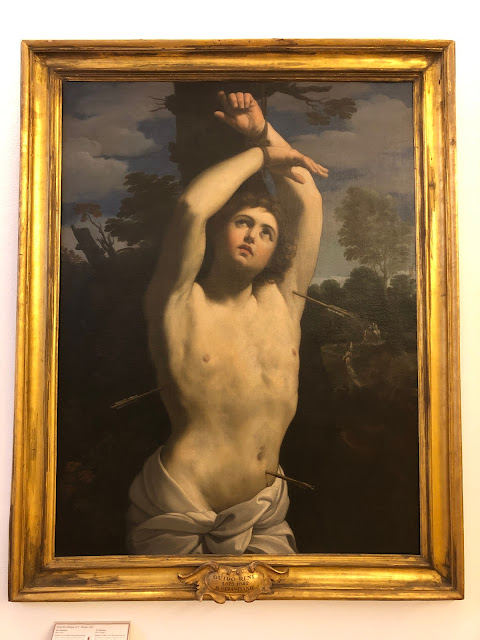【ローマ】カピトリーニ美術館 レーニ、グエルチーノ、コルトーナ Roma - Musei Capitolini : Reni, Guercino and Cortona
グイド・レーニの『聖セヴァティアヌス』。1615年から1616年にかけて描かれた作品。
グイド・レーニは、ボローニャ出身の画家で、ボローニャ派を代表する画家の一人。
アンニーバレとアゴスティーノのカラッチ兄弟によってボローニャ・アカデミーが創設されて、フィレンツェやヴェネツィアとは少し違った独自の宗教画などを描いた。
グイド・レーニの絵は、透明感があって神秘的な雰囲気の作品が多い。
Guido Reni's Saint Sevatian. A work painted between 1615 and 1616.
Guido Reni was a painter from Bologna and one of the representative painters of the Bologna school.
The Bologna Academy was founded by the Carracci brothers Annibale and Agostino, and he painted his own religious paintings that were a little different from those in Florence and Venice.
Many of Guido Reni's paintings have a transparent and mysterious atmosphere.
同じくグイド・レーニの『祝福された魂』。
1640年から亡くなる1642年にかけて描かれた作品。
写実的というよりは幻想的でスピリチュアルな世界観が画面に満ちている。
グイド・レーニが最後に到達した絵画世界の境地が体現されているようで、とても心に残る印象的な作品だ。
"Blessed Souls" by Guido Reni.
A work painted between 1640 and his death in 1642.
The picture is filled with a fantastic and spiritual view of the world rather than realistic.
It seems to embody the state of the painting world that Guido Reni reached at the end, and it is a very memorable and impressive work.
グエルチーノの『聖ペトロネラの埋葬と昇天』。
グエルチーノは後期のボローニャ派を代表する画家で、この絵はサン・ピエトロ大聖堂のために描かれて、グエルチーノの名前を一躍有名にした作品。
グエルチーノは、グイド・レーニより15歳ほど年下で、活動時期も重なっていたが、ボローニャ派の流れを引き継いだ。
教皇になる前、ボローニャ時代にグエルチーノを多用したグレゴリウス15世は教皇になるとグエルチーノをローマに呼び呼び寄せた。
グエルチーノはそのグレゴリウス15世が亡くなるまでローマで活躍し、その後はボローニャに戻った。
Guercino's Burial and Ascension of Saint Petronella.
Guercino is a painter who represents the late Bologna school, and this painting was painted for St. Peter's Basilica and made Guercino's name famous.
Guercino, who was about 15 years younger than Guido Reni and whose activities overlapped with him, continued the tradition of the Bologna school.
Before becoming pope, Gregory XV, who used Guercino extensively in Bologna, summoned Guercino to Rome when he became pope.
Guercino remained active in Rome until the death of Pope Gregory XV, after which he returned to Bologna.
グエルチーノの作品は、ボローニャ派の特徴である柔らかな印象を保っているが、一目でグエルチーノとわかる独自の絵画世界を作り上げた。
聖家族を描いたこの作品も、幼子イエスと彼を見つめる聖母マリアの表情は、宗教画というよりは風俗画のような親しみやすさを感じる。
Guercino's work maintains the soft impression characteristic of the Bologna school, but creates a unique world of painting that is instantly recognizable as Guercino.
In this work depicting the Holy Family, the expression of the infant Jesus and the Virgin Mary looking at him gives us a sense of familiarity, more like a genre painting than a religious painting.
グエルチーノについては、2015年に日本で大規模な展覧会が開催された。
この美術館にはその時に展示された絵画はなかったようだが、その独自の様式の絵画は、別な作品を見てもそれがすぐにグエルチーノの作品であることを教えてくれる。
グエルチーノは、ローマ時代はカラヴァッジョなどの影響を受けて『聖ペトロネラの埋葬と昇天』のようなダイナミックな構成の作品が多い。
しかし、ボローニャに戻ってからは、穏やかな親しみの感じられる古典的な絵画を描くようになった。
それは絵画史的には後退したと評価されてしまったようだが、むしろそうした画風の方がグエルチーノの個性がより発揮されているように思える。
As for Guercino, a large-scale exhibition was held in Japan in 2015.
This museum does not seem to have had any paintings on display at the time, but the unique style of paintings makes it easy to recognize another work by Guercino.
In the Roman era, Guercino was influenced by Caravaggio and others, and many of his works have dynamic composition such as "The Burial and Ascension of St. Petronella".
But when he returned to Bologna, he turned to classical painting with a gentle familiarity.
It seems that it has been evaluated as a retreat in the history of painting, but it seems that such a style of painting shows more of Guercino's individuality.
大きなカンファレンスルームのような部屋の四方の壁に、巨大な絵画が部屋を取り囲むように展示されていた。
この部屋は、ピエロ・ダ・コルトーナの部屋と呼ばれている。
ピエロ・ダ・コルトーナと言えば、ローマに着いた日にホテルに程近いバルベリーニ宮で巨大な天井画を見て圧倒された。
日本ではあまり知られていないが、コルトーナは絵画の他にも建築家としても知られ、ベルニーニやボロミーニと並んでバロックを代表する芸術家の一人だ。
Huge paintings were displayed on the four walls of a room that looked like a large conference room.
This room is called the Piero da Cortona room.
Speaking of Piero da Cortona, the day he arrived in Rome, he was overwhelmed by the huge ceiling paintings at the Palazzo Barberini, near his hotel.
Although not well known in Japan, Cortona is known not only as a painter but also as an architect, and is one of the representative Baroque artists along with Bernini and Borromini.
コルトーナの『サビニの女たちの略奪』。
こちらは先ほどの絵と違ってダイナミックなシーンが展開している。
古代にローマが誕生した際に、ローマには女性が少なかった。そこて近隣のサビニ族から女性を略奪したという話がリウィウスの『ローマ建国史』に書かれている。
現代の視点からでは、コンプライアンス的にアウトな作品だが、ルネサンス以降のヨーロッパではよく描かれるテーマに一つだった。
3人のサビニ族の女性を中心にした構図の中に、母親を奪われて悲しむ子供や、娘を奪われまいと抵抗する年老いて父親など、劇的なシーンが展開されている。
Cortona's Rape of the Sabine Women.
Unlike the previous picture, this one has a dynamic scene.
When Rome was born in ancient times, there were few women in Rome. There is a story written in Livy's "History of the Founding of Rome" that he plundered women from the neighboring Sabines.
From a modern point of view, it is a work that is out of compliance, but it was one of the themes often drawn in Europe after the Renaissance.
A dramatic scene unfolds in the composition centering on the three Sabine women, such as a child grieving over the loss of his mother, and an old father resisting the loss of his daughter.









コメント
コメントを投稿